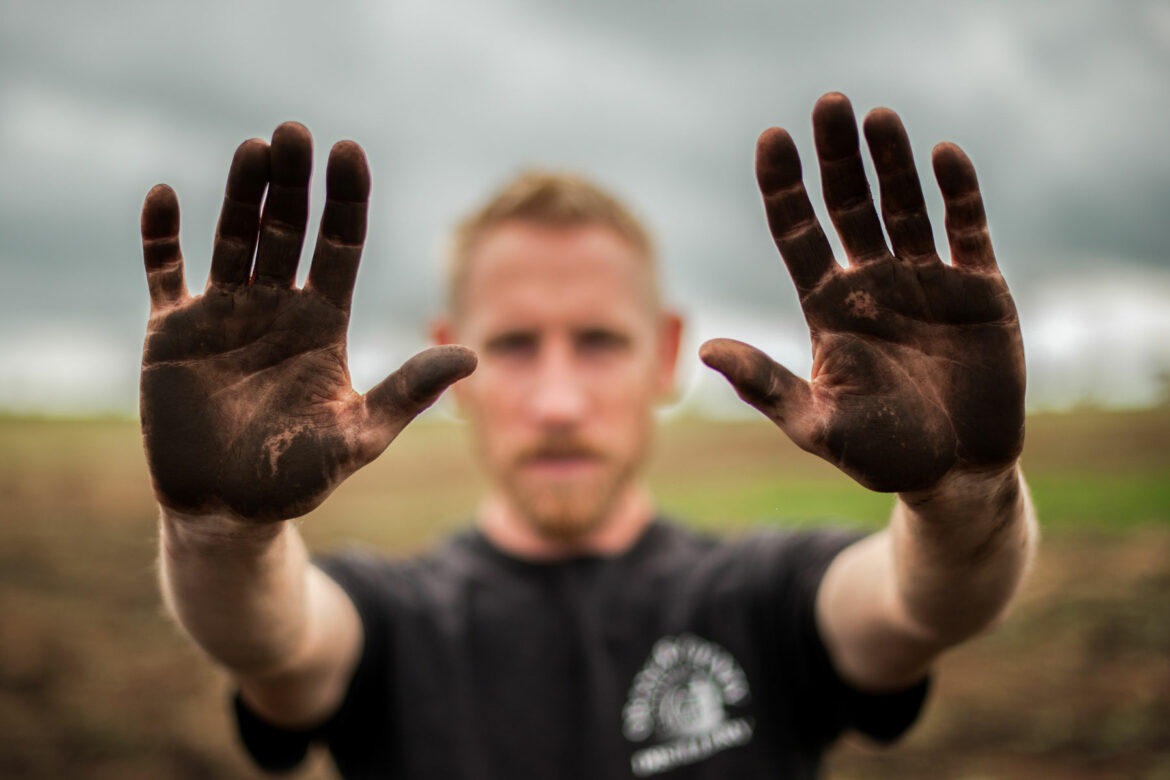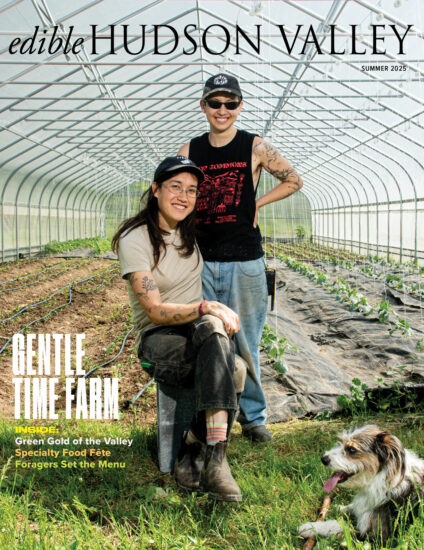Standing out here, you might not know you were just 90 minutes from Manhattan. Nestled in the heart of New York’s Orange County, the “Black Dirt Region” holds roughly 26,000 acres of the most fertile soil in the country. This miracle soil, black as night, is what remains of a glacial lake that melted 12,000 years ago. It’s illegal to sell and coveted by the farmers who understand its gifts.

A Deep Discovery
Initially called “The Drowned Lands,” the swampy bog left by the melted lake wasn’t utilized by the first wave of British and Dutch immigrants, because they were unaware that a gold mine of mineral-rich black dirt lay beneath. In her book about the region, Pride and Produce, Cheetah Haysom writes that around 1880, Polish and Volga German immigrants arrived and “recognized the swamp bed as chernozem, the dark, humus-rich soil of their own home country.” They drained the valley through a system of hand-dug ditches, revealing the black soil, transforming it into the fertile farming region it is today.
Picture a bed of crushed Oreos. Jet black in color yet light in texture, the soil’s wow-factor is not just its arresting color, but its composition. Affectionately termed “muck,” it is between 30% and 90% organic matter; typical soil is less than 10%. Farmer Tony Bracco says that unlike most soil that needs constant irrigation and fertilizing, this black dirt is like a giant heap of compost: high in nitrogen and sulfur, and absorbent.




Onions
The soil’s high sulfur content helped make one crop king of the region: the onion. The sulfur helps produce the spicy yellow onions the region is known for. It also creates a high level of pyruvic acid, which is the reason you bawl your eyes out doing kitchen prep.
Black Dirt onions have the same amount of sugar as their sweet counterparts of the Granex variety—Vidalia, for example—but less water, resulting in a sturdier texture and stronger onion flavor, making them better for cooking and caramelizing.
The Onion Farmer
It’s no surprise then that the region is filled with legacy farmers. Fourth-generation onion farmer Chris Pawelski grows a wide variety of alliums with names like Merengue, Montclair, Scorpion and Red Defender. With over 30,000 followers on Twitter, @ChrisPawelski (his “humor outlet”) and a passion for farming and policy work, Pawelski is a bridge between the old guard and the new. He speaks with erudition about advocacy, but peppers his speech with language as filthy as the dirt around him, teaching me my new favorite phrase: “Grade-A asshole.”
Newcomers
Pawelski also rents some of his land to farmers like Chinese brothers Yong Le Gan (former guard at Rikers Island), Kelvin Kam (former diamond setter) and Bo Gan, who worked at a clothing factory. They are among a wave of first-time farmers who’ve come to the Black Dirt region. They’re growing more than just onions: crops like baby bok choy and yu choy supplying New York’s Chinatown and Brooklyn.
Other newcomers include Tony Bracco, graphic designer turned farmer, who bought 25 acres in 2009. Bracco grows a diversity of crops, and started his CSA program in 2011. Among the challenges is the “big disconnect” between city slickers who buy from farms and the country. “They no longer understand what farm life and farm business is and how it works.” Americans also pay less for produce than any country in the world, producing a consumer base that would rather buy cheap at the supermarket. Bracco is proud of his produce. He walked me through his farm and greenhouse, bending down to snip some cut-to-order chard, recalling the time Thomas Keller came through and sampled his microgreens. “He said in my ear, ‘Good job, Tony.’” Mention of the chef brings a smile across Tony’s face as wide as the ditch surrounding his land.

Princess Rebel
Many of these new farmers owe some thanks to Cheryl Rogowski, Princess of the 1983 Onion Harvest Festival and, more importantly, the first farmer to ever receive a MacArthur “Genius Award.” Rogowski was raised on an onion farm, tracing her family’s roots to her great-grandfather Leonard Filipowski who settled here in the late 1800s.
But Rogowski wanted to branch out from onions. By the time she was a young adult, she drove her father crazy by asking to grow new crops. So he gave her five acres to do whatever she wanted with. “I started growing things like white pumpkins and sunflowers and the weird summer squashes, like the star-shaped ones, the Pattypans, things you didn’t see back then. At that time no one would even consider things like that because this was onion country, and if you didn’t grow onions something wasn’t right.”
Rogowski is important for her influence on crop diversification and championing community-supported agricultural (CSA) harvest subscription programs, helping to form the farming region you see today. She says that the soil brings something special to the produce. “We always talk about terroir with wine, but we never talk about it with our food.” Because of the mineral content and moisture in the soil, Rogowski says “there is a distinct difference and it shows. It comes through in the flavor.”
Hooch Men
There’s a new generation of farmers and entrepreneurs who see the black dirt not just as a gold mine for edibles, but for drinkables. A change in state liquor laws and a booming interest in craft beverages have rejuvenated a once-thriving industry wiped out by Prohibition.
John Glebocki is a fifth-generation farmer who grew up farming onions with his grandfather. Golden-haired and lean, Glebocki still farms the same property that his great-great-grandfather bought 120 years ago, but because of the high cost of labor was on the hunt for something else to do with the land. “Alcohol is the best bang per pound of anything you could grow in this black dirt,” he said, wiping the honey from his hands to greet me at Orange County Distillery, which he opened with Bryan Ensall in October 2014.
The two got serious after New York passed the Farm Distillery Act in 2007, which dramatically slashed the licensing fee from the high thousands to $128. The license allows farms not only to produce 35,000 gallons of liquor a year (as long as it’s made with 75% NYS ingredients), but to sell it right on the premises, helping turn the farming region into a destination for libation lovers.
Glebocki handles the dirty farming while Ensall gets his fingers deep in paperwork. But they overlap tasks like any small business: mashing, fermenting, distilling, aging, bottling and marketing their booze. A true farm-to-bottle operation, the distillery operates in a 100-year-old red barn, right on the black dirt where they farm, and their small size gives them flexibility to experiment and craft spirits at their own pace. Glebocki started out growing rye, barley, corn, then realized the sugar beet was a good place to start, because he could treat it like a fruit and distill vodka from it. While aged spirits take anywhere from months to years, clear alcohol can be made in the blink of a week. Once the duo had a good grasp on creating mashes and the fermentation process, they were ready to tackle aged spirits. They became the first distillery to sell at the farmers markets in NYC.
How does the farming community react to a fifth-generation onion farmer getting into the hooch biz? “For them to see someone like me, that has been farming produce for so long, change directions to alcohol, it’s kind of caught people off guard,” said Glebocki. For the young farmer, who started growing wholesale single-crop onions, then transitioned to retail produce, and then hit pay dirt with alcohol, there’s no looking back, especially as a bottle of OCD bourbon retails at $37. “There’s no way I’m going to put twice as much work into a can of tomato sauce for $6,” said Glebocki.




Beer Guy
Former accountant Mike Kraai searched high and low for a place to open a brewery. That’s when he discovered an old firehouse in Pine Island and transformed it into a brewery and tap room, which opened in the fall of 2015.
Kraai said the beer and spirits scene is “very new in the area. We’re the first brewery in the Warwick area.” The black dirt is the backyard of the pub’s outdoor beer garden.
Alongside the microbrew staples, there’s one black sheep of a beer that he brews in a nod to the region: Drowned Lands Saison. Infused with local Candy onions, a sweet variety that he gets ¼ mile from his brewery, the ale is brewed during harvest season when the fields are full of onions. “We just had to do it because it’s our local ingredient,” said Kraai. The beer was well-received by locals, even if they were “afraid of it at first. People loved it. We sold out quickly.”
Kraai handles distribution himself, driving around kegs in his VW Golf. “When we first opened people thanked me, because there’s not much else around,” said Kraai. “This has been good for the community as a whole.”
While sampling the Pine Island brews, I talked with carpenter Mark Negersmith, who told me that his first job, at age 12, was on an onion farm. “I show up and they give me a basket of onion bulbs.” His job? To push them into the dirt with his thumb. “Have you seen the length of these fields? Exactly.” Negersmith called it “very honest work. I made $80 that week and I was so proud of that money. After that week, I told myself, ‘I’m never doing that again.’ I’m a carpenter now, and it’s very easy compared to that,” he said, downing the last of his beer, sitting in a stool firmly atop the rich black ground.
Rogowski reminisces about the days when “you looked across the valley and saw and smelled nothing but onions” yet is excited about the changes in the region. While driving through Pine Island recently she noticed a local cidery’s barrels in the back of the truck, and a hop farm being put in down the road. “I think like anything, people are trying to survive but in ways they enjoy.”
She knows as well as anyone the role innovation and diversification play in long-term farming success. “To see that farmers are trying new things to thrive and succeed so they can be here 20, 30, 40 years from now and hopefully their great-grandchildren can farm and be successful at it, gives me hope for the future.” And just like everything comes around eventually, she added, “It could very well be that those kids go back to onions.”
Mastodon Country
Beneath the Black Dirt lies a paleontologist’s dream: A wealth of bones from the Age of Giants

The Black Dirt region is an “extremely rich fossil bed,” says Guy Robinson, a biologist at Fordham University who studies the paleoecology of Orange County and the mid-Hudson Valley. The deep lakebed is the perfect storage container for the remnants of now-extinct animals of the late Ice Age, including mastodons, Jefferson’s ground sloths (must Google) and elk-moose.
There are three layers here: clay at the deepest, a mix of peat and clay in the middle (where the bones are typically found) and black dirt on top. Most bones are discovered by farmers maintaining drainage ditches after the fall harvest, and because there is no obligation to turn over bones unless they are human, Robinson said many “are still sitting around in barns and toolsheds.” Local farm worker Rich Van Sickle dug up an almost complete elk-moose skeleton, one of the animals extinct since the end of the last Ice Age. Robinson understands farmers wanting to keep them: “They’re extremely cool to show off.”
This story was originally published in March of 2017.



